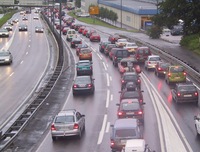
|
| A negative unintended effect of the CO2-differentiation of vehicle taxes in Norway has been higher share of diesel cars and thus higher emissions of NOX and PM-10 particles. |
The first OPTIC report: “Inventory of measures, typology of non-intentional effects and a framework for policy packaging” is now available.
It is notable that unintended effects were reported for the majority of the examples in the inventory, and predominantly negative, although positive effects and examples with mixed consequences were also reported.
One example is CO2-differentiation of vehicle taxes in Norway. While this is reported to contribute to reducing CO2 emissions from cars, one negative unintended effect has been a higher proportion of diesel-engine cars and thus higher emissions of NOX and PM-10 particles in urban areas.
Another example is the construction of a new 50 km road connection through a remote island area. The link has contributed to reduce travel times significantly, but also appears to foster regional disintegration due to a division of established public transport and freight routes
.
In the Czech Republic a motorway toll system for lorries has reportedly led lorries to start use low class roads, with potential negative environmental and safety effects.
An example of a positive effect is the introduction of digital tachographs, which in Germany is reported to have helped trucking companies improve their fleet management abilities.
More examples are listed in the report. Evidence of unintended effects is sometimes scarce or even non-existent. In the inventory of measures no clear relationships were found between the type of measure introduced and the nature of positive or negative unintended effects.
There is a clear need to seek a better understanding of the unintended effects as a first step of providing proper remedies against them.
Future OPTIC reports will address:
• Modelling tools and methods for early detection of adverse effects (expected online November 2010)
• The integration of risk, uncertainty and irreversibility into planning process (expected online November 2010)
• Examples of good practice in policy packaging in Europe
• Barriers to policy adoption and implementation of policy packages
• Synthesis of best practices in policy packaging and policy recommendations on policy packages
Download Deliverable 1:
Inventory of measures, typology of non-intentional effects and a framework for policy packaging
